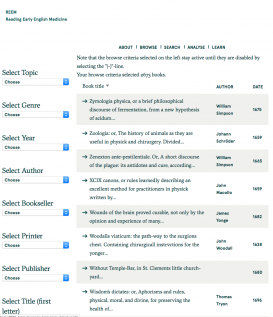Our History
The REM database is based largely on bibliographic data from the ESTC with additional data and analysis by project authors. Mary Fissell began work on this database in the late 1990s, attempting to document medical writing for a vernacular readership in early modern England, 1640–1800. At that point, she saw the project as providing context for her work on the book that became Vernacular Bodies by sketching out the shape of the market for popular medical books. Access to primary texts was not yet digital—one read the book itself or a microfilm. She did a key word search in ESTC titles and then examined the book’s claims to its intended readership to assess if it were for a vernacular readership.
When invited to contribute a chapter Popular Medical Print to the Oxford History of Popular Print Culture, Fissell pushed the project’s remit back to the beginning of print, and realized some of the depths of her ignorance. In talking with Elaine Leong, the project was re-conceived more broadly as being about all vernacular medical print in England up to 1700, and Leong built a team at the MPIWG to bring the project to a much wider audience of scholars; the project has a dual mission fostering both pedagogy and research.
Later, the team at the MPIWG (Leong with Glombitza and Taape) extended the scope of the database to include all English-language medical books listed in the ESTC up tp 1700. Key words used to search for and identify medical books in the ESTC include medic*, physic*, physit*, curg*, chirur*, apoth*, doctor*, midw*, drug*, cure*, remed*, illness*, sick*, ail*, heal*, disease*, regiment*, pharma*, malad*, fever*, pox*, pest*, plague*, surg* (where * is a truncation). In later stages of the project, in recognition that many English medical texts were translations of writings in Latin or European vernaculars, the team also searched for medical authors including well-known ancient authorities such as Hippocrates and Galen and contemporary authors like Jean Fernel, Amatus Lusitanus and Daniel Sennert.
The project takes an inclusive view of “health and healing” as a topic in printed works in early modern England. We have excluded works whose health and healing content was low—less than about 30% of the book. We also excluded almanacs. Although they often included some healthcare information such as good times for bleeding, such information was a relatively low proportion of the text, and, more important, almanacs are a very substantial and clearly-defined genre of their own. Nor have we included Bills of Mortality, the lists of deaths in London that specified cause of death in order to keep tabs on the spread of the plague. Like almanacs, they re a very specific genre with substantial scholarly work developed to them. To our surprise, there were few works that proved difficult to assess for inclusion.
To aid research and to foster access to texts, the project categorized each book according to genre and topics covered; work is ongoing to categorize the stated occupation(s) of a work’s author. In categorizing Genre, we used period-appropriate categories, that is, we used categories that early-modern English readers would recognize, and which presumably authors were attempting to match. For Topics, we have included modern search terms, to help novice students unfamiliar with the early modern world to find works of interest. For example, we use the modern term “Reproduction” as a topic for midwifery books, where early moderns would probably have referred to processes of generation, not reproduction. For both Genre and Topic, there can be multiple entries for a single work.
